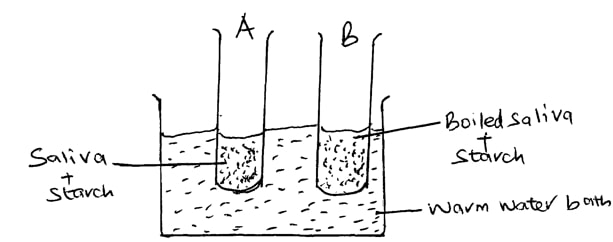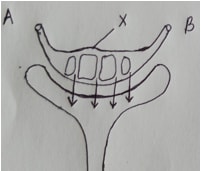INSTRUCTIONS TO CANDIDATES
- Answer ALL questions in the spaces provided.
- All workings must be clearly shown where necessary.
QUESTIONS
- State three activities of the cell that are controlled by the nucleus (3mks)
- The graph below represents the growth pattern of animals in a certain phylum.

- Name the type of growth curve shown above. (1mk)
- Identify the process represented by X. (1mk)
- Name the hormone responsible for the process in b(i) above. (1mk)
- State the importance of the growth of a pollen tube to a plant. (1mk)
- Name the causative agent of the following diseases in human (3mks)
- Amoebic dysentery
- Bilhazia
- Typhoid
- Give three reasons why plants do not require specialized excretory organs (3mks)
- An experiment was set up as shown below

The set up was left for 30 minutes.- State the expected results (1mk)
- Explain your answer in (a) above (3mks)
-
- What is the function of Sodium hydrogen Carbonate that is added to test solution of non-reducing sugar. (1mk)
- The equation below represents a process X which is controlled by enzymes.
C6H12O6 + C6H12O6 ⇌ C12H22O11 +H2O
Glucose + Fructose Sucrose + Water- Name the process X and enzyme R
Process X (1mk)
Enzyme R (1mk)
- Name the process X and enzyme R
- What is the importance of the counter current flow in the exchange of gases in a fish. (2mks)
- State two ways in which the tracheoles of an insect are adapted to their functions. (2mks)
- List down four phenotypic characteristics that have been selected for the production of strains suitable for modern agricultural purposes. (4mks)
- State the branch of Biology that deals with: (2 marks)
- Study of birds
- Study of the chemical composition of organisms
- A certain mammal has no incisors, no canines, 6 molars and 6 premolars on the upper jaw. It has 6 incisors, 2 canines, 6 premolars and 6 molars on the lower jaw.
- Write its dental formula (1 mark)
- Suggest with reasons the possible mode of feeding of the animal. (2 marks)
- Some herbaceous plants have very little strengthening tissue yet they remain firm and upright. Give a reason for this observation. (1 mark)
- Name the strengthening material in the following tissues. (2 marks)
- Collenchyma
- Xylem vessels
- State two functions of Aerenchyma tissue in plants. (2 marks)
- A woman gave birth to a child of blood group B+ (B positive). Name two antigens that determined the child’s blood group. (2 marks)
- In an experiment to investigate an aspect of digestion, two test tubes A and B were set up as shown below.

- The test tubes were left in the warm water bath for 30 minutes. The contents of the test tubes were tested for starch using Iodine solution.
State the observations in: (2 marks)
Test tube A
Test tube B - Account for the results in (a) above. (2 marks)
- The test tubes were left in the warm water bath for 30 minutes. The contents of the test tubes were tested for starch using Iodine solution.
- Explain each of the following
- Variegated plants accumulate less food than non-variegated plants under similar conditions.(1mark
- Most leaves are thin with broad leaf surface. (1mark)
- State three importances of photosynthesis in an ecosystem. (3marks)
- Wing of an insect, wing of a bird, hand of a man, flipper of a whale, foreleg of a horse are locomotory structures in animals. Using the structures listed above state the ones considered as
- Homologous structures (1mark)
- Identify the type of evolution that brings about homologous structures. (1mark)
- A certain plant was found to have the following features
Parallel venation of leaves
Sheath like petiole
Flower parts in multiple of three- Name the class to which the plant belongs. (1mark)
- Suggest the expected arrangement of vascular bundle in the stem of the plant. (1mark)
- Explain the reason for each of the following in flowering plants
- Wind pollinated flowers produce large number of pollen grains. (1mark)
- Insect pollinated flowers have small sticky stigmas that an firmly attached to the style. (2marks)
- The following is part of a kidney nephron,

-
- Name the process represented by the arrows (1mk)
- Name the conditions necessary for the process named in (a)(i) above to take place (2mks)
- Name one blood component present in the figure above (1mk)
-
- what is seed dormancy (1mk).
- state two ways in which seed dormancy can be broken (2mks)
- Explain why several lateral buds sprout when a terminal bud in a young tree is removed. (3mks)
- Below is a diagram of an organelle that is involved in aerobic respiration.

- Name the organelle (1mark)
- Name the parts labeled;
A (1mark)
B (1mark)
C (1mark) - What is the purpose of the in-foding labeled D? (1mark)
- Give the mechanical compound which is formed in the organelle and forms the immediate source of energy (1mark)
- State the function of the following parts of a light microscope
- Clip (1mark)
- Eye piece lens (1mark)
- When focusing under high power objective lens the coarse adjustment knob should never be used for focusing. Explain (2marks)
-
- Name two defects of the circulatory system in humans. (2marks)
- Explain two protective functions of mammalian blood. (3marks)
MARKING SCHEME
-
- cell division
- Cell growth
- Protein synthesis
- Cell respiration
- Cytoplasmic streaming
- Cell secretion/excretion
-
- Intermittent growth curve;
-
- Growth;
- Ecdysone/ mounting hormone;
- Results in fertilization by conveying the male gametes to the female gamete; rej. It carries/transport/medium
-
- Salmonelatyphi
- Entamoebahistolytica
- Schistosomamansoni
-
- Waste products in plants are mainly made from carbohydrate which are not as harmful as those from the protein materials.
- Waste products are formed slowly /little accumulation of wastes / plants are less active; wastes such oxygen and carbon (iv) oxide are re-usable / recycled;
- Some wastes such a gum and resin are stored in insoluble forms in dead tissue;
- Some wastes can be removed by diffusion;
-
- Visking tubing in volume /bulge/swell/expand res. Turgid
- Water move from the beaker to the visking tubing by osmosis through semi-permeable membrane. Sucrose in the visking tubing is hypertonic to water in the beaker.
-
- Neutralise excess acid (Hcl); rej. Without excess.
- X – Condensation;
R – Sucrase/ invertase;
-
- Maintains a steep concentration gradient across the respiratory surface; ensuring maximum extraction of oxygen from water to the blood; rej. Without steep concentration gradient (2mks)
-
- Thin epithelium for faster/ rapid diffusion of gases; rej. Without fast/ rapid
- Have tracheole fluid/ moist surface to dissolve gases in solution before diffusing;
- Highly branched to increase surface area for gaseous exchange; (mark first two)
Rej. Highly vascularised
Thin wall for epithelium
-
- Resistance to diseases.
- Early maturity
- Adaptations to local conditions
- High yields
- Increased length of production
-
- ornithology;
- Biochemistry;
-

- Herbivorous; No incisors and canines on the upper jaw;
-
- Herbaceous plants absorb water through osmosis, parenchyma cells become turgid and plants gain support by turgor pressure;
-
- Cellulose and pectins;
- Lignin;
-
- Maintaining buoyancy;
- Storage tissue;
-
- Antigen B;
- Rhesus antigen;
-
- Test tube A - Brown colour of iodine solution remains;
Test tube B - Blue -black colour observed; - In test tube A, starch was broken down by action of salivary amylase in saliva to maltose; while in test tube B, the enzyme salivary amylase in saliva was denatured by boiling;the beaker to the visking tubing by osmosis through semi-permeable membrane. Sucrose in the visking tubing is hypertonic to water in the beaker.
- Test tube A - Brown colour of iodine solution remains;
-
- Variegated leaves have less chlorophyll hence synthesize less food while non-variegated leaves are entirely green with more chlorophyll hence synthesize more food; 1mk
-
- Thin membrane enhance easy diffusion of carbon (IV) oxide;
- Broad leaves increases surface area for photosynthesis process; 1mk
-
- Production of food;
- Production of oxygen;
- Removal of carbon (IV) oxide from the air; 3mks
-
-
- Wing of a bird, hand of a man, flipper of a whale and foreleg of horse; 1mk
NB Mark as a whole - Wing of an insect and of a bird; 1mk
- Wing of a bird, hand of a man, flipper of a whale and foreleg of horse; 1mk
- Divergent; 1mk
-
-
- Monocotyledonae
- Vascular bundles are randomly scattered within the cortex; 1mk
-
- To increase the chances for pollination; 1mk
- So that the pollen grains on the insect’s bodies stick onto them; firmly attached to avoid any breakage when the insect makes contact; 2mks
-
-
- Ultra filtration
- sufficient pressure to force the filtrate through pores in the endothelium of glomeruli and epithelium of Bowman’s capsule to allow selective filtration.
-
- urea
- Glucose
- Amino acids
- salts.
-
-
- inability of seed to germinate despite all the conditions necessary for germination being provided.
-
- scarification
- Removing germination inhibitors
- Allow embryo to mature before planting
- Increase concentration of hormones which stimulate germination
- High auxin concentration produced by terminal bud/ apical meristem, inhibits lateral buds growing into branches; removal of terminal bud/ apical bud lowers the concentration of auxins/ lowers the inhibition effect (hence sprouting of lateral buds; Rej without high concentration
-
- Mitochondrion; 1mk
- A – outer membrane;
B- inner membrane;
C – matrix; 3mks - Increase the surface area over which respiration takes place; 1mk
- Adenosine Triphosphate (ATP); 1mk
-
- Hold the specimen on the slide to keep it in a firm position; 1mk
- Contributes to the total magnification of the specimen together with the objective lens; 1mk
- The coarse adjustment knob moves the body tube over longer distances; it would easily cause the objective lens to hit/tough the slide and cause destruction of both slide and lens; 2mks
-
-
- Thrombosis; Accept coronary thrombosis;
- Cerebral thrombosis
- varicose veins;
- High blood pressure/Hypertension;
- Arteriosclerosis; 2mks
-
- Platelets initiates blood clotting on damaged vessel. The clot prevents entry of pathogenic micro-organisms;
- Some white blood cells (Phagocytes) engulf and digest pathogens thus protecting the body against pathogens;
- Lymphocytes secretes antibodies that destroy pathogens and their secretions; max 2mks
-
Join our whatsapp group for latest updates
Tap Here to Download for 50/-
Get on WhatsApp for 50/-
Download Biology Paper 1 Questions and Answers - Murang'a County Mocks 2020/2021.
Tap Here to Download for 50/-
Get on WhatsApp for 50/-
Why download?
- ✔ To read offline at any time.
- ✔ To Print at your convenience
- ✔ Share Easily with Friends / Students

